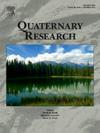纳米布沙海边缘约39000年的植被和气候变化记录
IF 1.8
3区 地球科学
Q3 GEOGRAPHY, PHYSICAL
引用次数: 1
摘要
本文介绍了纳米布沙漠中部在过去约39000年的大部分时间里首次连续的气候和植被变化多代理记录。稳定的碳和氮同位素、花粉和微珊瑚的证据表明,冰川时代与全新世气候和植被类型之间存在显著差异。尽管仍然干旱到半干旱,但海洋氧同位素阶段(MIS)2-3的条件明显比全新世晚期更潮湿。相当大的相关植被变化是明显的,在MIS 2–3期间,较低的温度和较高/更规律的降雨促进了相对中间灌木状的karroid植被的向西扩展。随着最后一次冰川-间冰期的转变,气温的升高和规律性降雨的减少导致了植被的显著变化,并建立了目前的xeric草原。潮湿条件促进的喀斯特植被的株间距不能有效地携带火灾,微气候记录表明,只有在干燥条件下,随着草地植被的发展,才会发生更大范围的火灾。与纳米布沙漠及其周边地区的其他陆地记录一样,没有发现任何开普省植物群元素支持先前假设的Fynbos生物群在最后一次冰川期的扩张。本文章由计算机程序翻译,如有差异,请以英文原文为准。
A ca. 39,000-year record of vegetation and climate change from the margin of the Namib Sand Sea
This paper presents the first continuous multi-proxy record of climate and vegetation change from the central Namib Desert extending over much of the last ca. 39,000 years. Derived from rock hyrax middens, evidence from stable carbon and nitrogen isotopes, pollen, and microcharcoal reveals significant differences between glacial-age and Holocene climates and vegetation types. Although still arid to semi-arid, conditions during Marine Oxygen Isotope Stages (MIS) 2–3 were significantly more humid than in the Late Holocene. Considerable associated vegetation change is apparent, with cooler temperatures and higher/more-regular rainfall promoting the westward expansion of relatively mesic shrubby karroid vegetation during MIS 2–3. With the last glacial–interglacial transition, increasing temperatures and less/less-regular rainfall resulted in marked vegetation changes and the establishment of current xeric grasslands. The inter-plant spacing of the karroid vegetation promoted by wetter conditions does not carry fire effectively, and the microcharcoal record indicates that more extensive fires may develop only with the development of grassier vegetation under drier conditions. As with other terrestrial records from the Namib Desert and environs, no Cape flora elements were found to support previously hypothesised expansion of the Fynbos Biome during the last glacial period.
求助全文
通过发布文献求助,成功后即可免费获取论文全文。
去求助
来源期刊

Quaternary Research
地学-地球科学综合
CiteScore
4.70
自引率
8.70%
发文量
57
审稿时长
3 months
期刊介绍:
Quaternary Research is an international journal devoted to the advancement of the interdisciplinary understanding of the Quaternary Period. We aim to publish articles of broad interest with relevance to more than one discipline, and that constitute a significant new contribution to Quaternary science. The journal’s scope is global, building on its nearly 50-year history in advancing the understanding of earth and human history through interdisciplinary study of the last 2.6 million years.
 求助内容:
求助内容: 应助结果提醒方式:
应助结果提醒方式:


